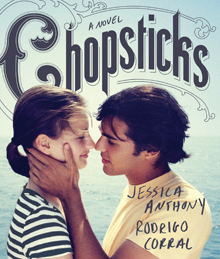
JESSICA ANTHONY Creating a new genre of fiction, with designer Rodrigo Corral. |
There's very little we writers like to do more than gnash our teeth about the future of our profession. Ack, Borders is going out of business! Village Soup newspapers are no more! We're all doomed to 99-cent e-books created by computers fed with algorithms created by dorks at MIT!Some writers choose, though, to take a swing at creating the future of our profession.
Such is the undertaking Jessica Anthony, author of the brilliant pomo novel The Convalescent, embarked upon with graphic artist Rodrigo Corral, creative director at publisher Farrar, Straus and Giroux, in Chopsticks, a "novel" told in photographs, graphic design, and illustrations, augmented (if you choose), with sound and video via the web or app.
You'll just have to get over the idea that someone as ridiculously talented with the English language is largely eschewing it in her storytelling. You could easily argue that this medium they've chosen plays more to Corral's strengths than Anthony's — how does a writer make the kind of ultra-fine point at which Anthony excels with nothing but imagery, photographs of notes and letters, and the sort of dialogue that can be related via captured text messages and a few chosen exultations set in giant font for effect?
Well, a writer can't. The story of teenage lovers Glory and Frank (get it? F and G are the first two paired notes in "Chopsticks," the waltz penned in 1877 by the 16-year-old Euphemia Allen, and those notes move farther apart and closer together . . .) is a fuzzy one. While there are plenty of "oh!" moments provided by the images you page through as you meet the piano prodigy and her Argentinean neighbor (or is he?), and you'll almost certainly page through the book quite a few times, taking in more and more each pass, there remains an overall lack of exactitude, both in what is going on in the story and in what you're being "told."
Sometimes, even, it's as though Corral felt he had to be extremely blunt to get a point across (and it's possible this is extra-true because this is a "young adult" novel). The sad-faced Glory in the Christmas card taken in the year of her mother's death is almost comical. We see pictures of Glory and Frank playing solitaire when they are separated (they're lonely! They miss each other!). Marc Scrivo, who plays Glory's overbearing (or is he?) father, is pretty ham-fisted in his scowls.
 |
For these reasons and more — and as a defender of the book as an art form, with hardcovers and paperbacks piled in every corner of my house, it pains me to say it — the app is actually a much better experience. The large and poignant photographs don't get split by the book's spine. You can click on and watch the Feist performance of "1234" that Frank and Glory watch together on the couch ("old teenage hopes are alive at your door"). When the texting of YouTube versions of "Chopsticks" becomes an in-joke with the pair, you can actually be in on it, rather than just looking at dead links on a printed page.Heck, when Frank makes Glory his mixtapes, you can actually listen to the indie and Argentinean rock and hear the message he's sending. Seekonk's "Tiny Lustre" is an achingly pretty song about a jellyfish sting, and it resonates wonderfully with the sea creatures that alternately express Glory's taste for fantasy and escape and feelings of being trapped by millions of slimy tentacles. But I don't know how you'd know that if you were just reading the book.